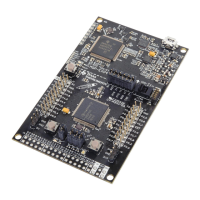BIAS_EN
Low
Power
Oscillator
LFEN
LF_TRIM
HFEN
HF_TRIM
LFLPO
HFLPO
HFLPO_VALID
nPORRST
RM46L852
SPNS185 –SEPTEMBER 2012
www.ti.com
4.6.1.2 Low Power Oscillator
The Low Power Oscillator (LPO) is comprised of two oscillators — HF LPO and LF LPO, in a single
macro.
4.6.1.2.1 Features
The main features of the LPO are:
• Supplies a clock at extremely low power for power-saving modes. This is connected as clock source #
4 of the Global Clock Module.
• Supplies a high-frequency clock for non-timing-critical systems. This is connected as clock source # 5
of the Global Clock Module.
• Provides a comparison clock for the crystal oscillator failure detection circuit.
Figure 4-5. LPO Block Diagram
Figure 4-5 shows a block diagram of the internal reference oscillator. This is a low power oscillator (LPO)
and provides two clock sources: one nominally 80KHz and one nominally 10MHz.
Table 4-10. LPO Specifications
Parameter MIN Typical MAX Unit
Clock Detection oscillator fail frequency - lower threshold, using 1.375 2.4 4.875 MHz
untrimmed LPO output
oscillator fail frequency - higher threshold, using 22 38.4 78 MHz
untrimmed LPO output
LPO - HF oscillator untrimmed frequency 5.5 9.6 19.5 MHz
startup time from STANDBY (LPO BIAS_EN High for 10 µs
at least 900µs)
cold startup time 900 µs
LPO - LF oscillator untrimmed frequency 36 85 180 kHz
startup time from STANDBY (LPO BIAS_EN High for 100 µs
at least 900µs)
cold startup time 2000 µs
64 System Information and Electrical Specifications Copyright © 2012, Texas Instruments Incorporated
Submit Documentation Feedback
